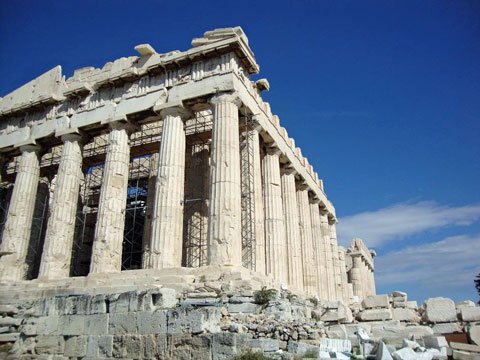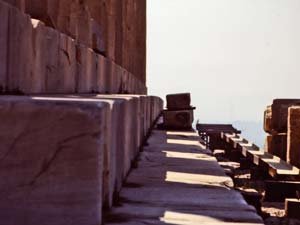The Parthenon was built in the aftermath of war. After the defeat of the Persians by the Greeks in 479 BC, the Athenians became the self proclaimed ‘protectors’ of the Greek world.
Although they may have started out with good intentions, Athens began to realize just how powerful they were. So although they did want to protect all Greeks from the Persians, they made sure they looked after themselves.
They set up what became known as the ‘Delian League’, which was designed to be a protective alliance for the Greeks against any future Persian aggression.
Other states gave money instead of ships to support the league, and once the Athenians had set up the navy, they used some of the surplus contributions to help fund a building program.

One of the most pressing aims of the Athenians was to replace the temples destroyed on the Acropolis. They also wanted a visible sign of the power and importance of Athens. Under Pericles’ leadership they decided in 448 BC to build the Parthenon.
Once the decision was taken, the architects chosen were Iktinos and Kallikrates. A sculptor friend of Pericles called Phidias was chosen to make the huge chryselephantine of Athena which would be situated inside the temple. Phidias was also given overall charge of the whole project.
Planning decisions
For the design of the Parthenon the Athenians decided on the fashionable Doric style of column. There were to be 8 columns along the front and rear (normally 6 were used), and 17 along the sides. The stylobate (top step of platform) was to have the normal 2 layers below it.

Some impressive mathematics…
- The ratio of the length of the temple to its width is 9:4
- The ratio of the distance between the columns (measured from centre to centre) to each column diameter is 9:4
- The ratio of the width of the front of the temple to its height is … you’ve guessed it – 9:4!

So the whole temple, although it looks simple in construction, has a harmony about it which is based on mathematics.

Now for the really clever stuff…
Not content with setting themselves mathematical targets, the architects of the Parthenon decided they needed to include more refinements. Of the many features they introduced, three in particular stand out.
First, they didn’t make the stylobate flat. Instead, they curved it upwards so the highest point was half way along. The ends of the stylobate are about 12 cms lower than the centre. In fact, this curvature starts in the foundations and is carried up into the entablature.
Second, they angled all the columns slightly inwards. The tops of the columns lean in by about 7cms.
Third, the columns taper in a slight arc where they reach the top. This gives them the impression of being compressed by the weight of the structure above them and bulging out slightly (entasis).

The result of these innovations is to remove the static look which the building would have had, and give it a sense of movement and interest.

Quarrying and transport
The marble used in the construction of the Parthenon came from the quarries on Mount Pentelicon, which is about 10 miles (16km) from Athens. The only reason they could have built such a large temple completely from marble was because of the close proximity of the quarries.
The men who did most of the work on the building were stone masons who specialized in marble. Those with a high level of skill would be employed, and it didn’t matter what their social status was. Slaves worked alongside freemen.
Your first view of the Parthenon
The architects chose the site of their temple very carefully. You enter the Acropolis through the Propylaia. As you come out of the Propylaia, you are presented with a view of the structure from the north west. This is a very imposing view, and was designed to impress everyone who saw it.
As you walk around the Acropolis, you’ll see the Parthenon from many viewpoints. Whatever your interest – or lack of it! – in ancient Greece, you can’t fail to leave the Acropolis without some admiration for those who designed and built the temple to Athena Parthenos.
